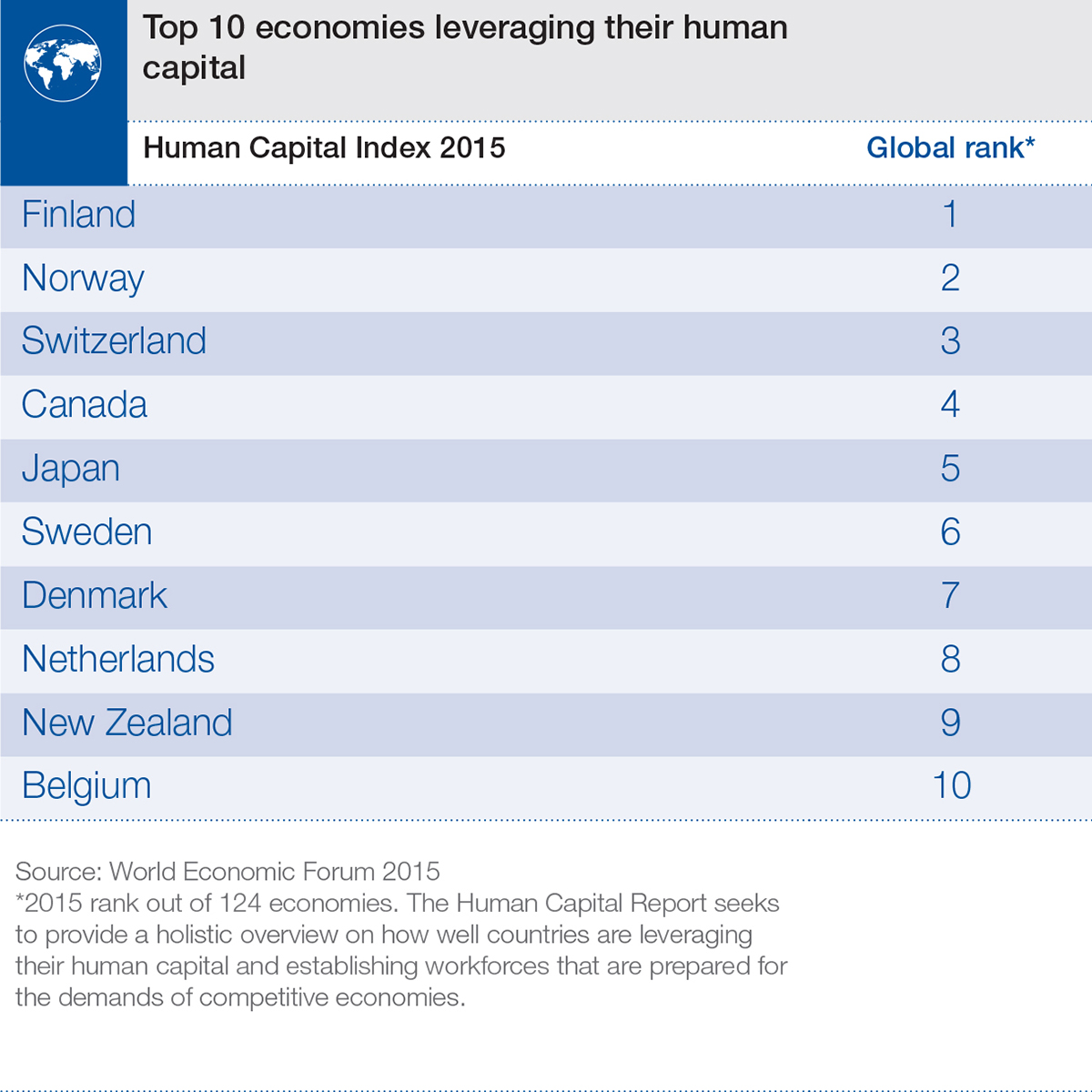Which country comes top for skills and education?
Stay up to date:
Future of Work
Europe dominates the global league table for skills and education with seven of the top 10 places. There are two representatives from Asia, one from North America, and none from the Middle East and North Africa, Latin America and the Caribbean or Sub-Saharan Africa regions.
However, detailed statistics from the World Economic Forum’s Human Capital Report 2015 show a more nuanced picture of the investments that nations are making in their people. This is a summary of the report in 10 charts.
Finland comes top of the global league table on the back of high rankings for almost all measures of education, skills and training and for all age groups. The country is best in the world for the quality of primary schools, youth literacy rates, and the ease with which businesses can find skilled workers. Norway (2nd) and Switzerland (3rd) perform almost as well as Finland across all age groups.
In Europe, France is the largest economy to make the regional top 10 list with Germany, Italy and the United Kingdom all failing to make the grade.
In Asia, Japan has both the world’s highest age-dependency ratio and the best education and skills provision for the over-65s. It also has the world’s highest rate for tertiary education of its working age population (50%). New Zealand is the only other Asian nation to make the global top 10 with youth unemployment below 5% and 90% of workers in medium- or high-skill jobs. Singapore scores highly for its young generation but gets marked down for the relatively weak educational attainment of its older population.
Latin American nations on average do much better than Asian economies for older citizens but not as well for younger people, which hints at the rise of Asia and some missed opportunities in the region.
Sub-Saharan Africa ranks in the lower half of the league table despite a solid performance by several nations in the region. Mauritius, Ghana and Zambia all have made enormous progress in education in recent years.
Gender gaps in secondary schools and the high incidence of child labour in certain countries of the Middle East and North Africa region risk leaving a lasting impact on the workforce of the next generation. Only three nations appear in the top half of the table with Israel scoring notably well on tertiary education and the United Arab Emirates and Qatar boasting very high ratings for overall education systems (9th and 3rd respectively.)
The United States comes near the top of the table for higher education and also leads the world in the number of graduates in the Arts and Humanities.
Luxembourg, meanwhile, tops the list of countries with the largest share of people in high-skilled employment, followed by Singapore and Switzerland.
Russia has more graduates in engineering, manufacturing and construction than any other nation, ahead of the US, Iran and Japan.
Saudi Arabia has more inactive tertiary-educated people than any other country – 37.3% of the population have post-secondary school qualifications but are not currently working.
The Human Capital Report 2015 is available here.
Explore the report by using the heatmap below:
Author: Till Leopold, Senior Project Manager, Employment, Skills and Human Capital, Gender Parity Programme and Human Capital, World Economic Forum. Tamara Leonardi, Project Manager, Employment, Skills and Human Capital, Gender Parity Programme and Human Capital, World Economic Forum.
Image: Patrick Manyika, 33, of Rwanda looks for a book in the library at the University of Redlands where he will starting his second master’s degree in Geographic Information Systems, in Redlands, California May 28, 2014. REUTERS/Lucy Nicholson
Don't miss any update on this topic
Create a free account and access your personalized content collection with our latest publications and analyses.
License and Republishing
World Economic Forum articles may be republished in accordance with the Creative Commons Attribution-NonCommercial-NoDerivatives 4.0 International Public License, and in accordance with our Terms of Use.
The views expressed in this article are those of the author alone and not the World Economic Forum.
Forum Stories newsletter
Bringing you weekly curated insights and analysis on the global issues that matter.
More on Economic GrowthSee all
Alexis Crow
May 23, 2025
Thelma Obiakor and Bisong Anthony Ekpang
May 23, 2025
Naoko Tochibayashi
May 23, 2025
Jack Hurd and Florian Vernaz
May 21, 2025
Benjamin Wiener
May 21, 2025
















